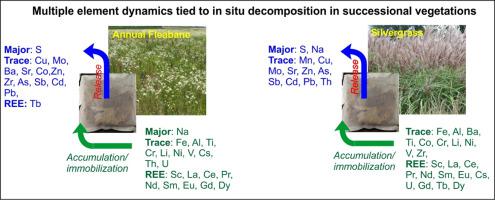Science of the Total Environment ( IF 8.2 ) Pub Date : 2020-09-16 , DOI: 10.1016/j.scitotenv.2020.142352 Mukesh Kumar Gautam , Kwang-Sik Lee , Björn Berg , Byeong-Yeol Song

|
Evaluating the decomposition-based change dynamics of various elements in plant litter is important for improving our understanding about their biogeochemical cycling in ecosystems. We have studied the concentrations of major, trace, and rare earth elements (REEs) (34 elements) in green tissue litter, and soil and their dynamics in the decomposing litters of successional annual fleabane (Erigeron annuus) and silvergrass (Miscanthus sinensis). Concentrations of major and trace elements in the litter of annual fleabane were 1.02–2.71 times higher compared to silvergrass. For REEs the difference between the two litter types for elements studied was in the range of 1.02–1.29 times. Both the litters showed a general decrease in the concentrations of elements in the initial stages of decomposition (60–90 days). All the major and trace elements (except for Na) in silvergrass showed a net increase in concentration at the end of the decomposition study (48.9–52.5% accumulated mass loss). Contrastingly, a few trace elements (Mn, Mo, Sr, Zn, Sb, and Cd) in annual fleabane showed a net decrease in their concentrations. For REEs, there was an increase in concentrations as well as in net amounts in both litter types. Similarities observed in the dynamics together with high and significant correlations among them likely suggest their common source. The higher concentrations of REEs in soil likely suggest its role in the net increase in REEs' concentrations and amount in litter during decomposition.
中文翻译:

韩国凉爽温带地区演替场地凋落物分解过程中的主要,微量和稀土元素动态
评估植物凋落物中各种元素基于分解的变化动力学,对于增进我们对它们在生态系统中的生物地球化学循环的理解至关重要。我们研究了绿色连续凋落物(Erigeron annuus)和银草(Miscanthus sinensis)中凋落的凋落物中绿色组织凋落物和土壤中的主要,痕量和稀土元素(REE)(34个元素)的浓度。)。一年生氟烷的凋落物中的主要和微量元素的浓度是银草的1.02-2.71倍。对于REE,所研究元素的两种垫料类型之间的差异在1.02-1.29倍之间。在分解的初始阶段(60-90天),这两个垃圾都显示出元素浓度普遍下降。在分解研究结束时,银草中的所有主要和微量元素(钠除外)均显示出浓度的净增加(累积质量损失为48.9–52.5%)。相反,一年生氟班烷中的一些微量元素(Mn,Mo,Sr,Zn,Sb和Cd)显示出浓度的净减少。对于稀土元素,两种凋落物的浓度和净含量均增加。在动力学中观察到的相似之处以及它们之间的高度显着相关性可能暗示了它们的共同来源。土壤中较高的稀土元素浓度可能表明其在分解过程中净增加稀土元素浓度和凋落物数量中的作用。











































 京公网安备 11010802027423号
京公网安备 11010802027423号